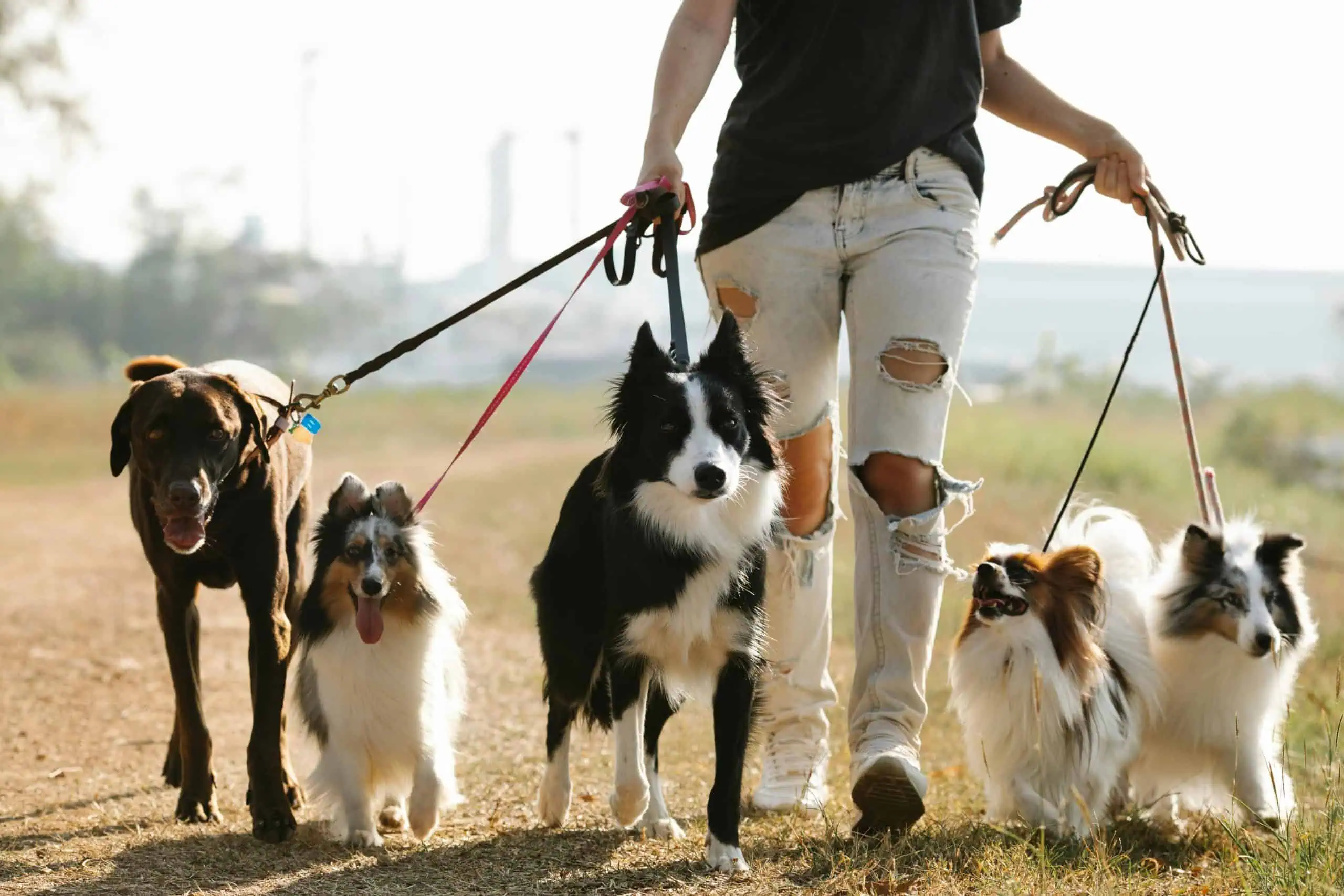Welcome to your comprehensive guide to launching a career in dog walking! If you adore dogs and relish the idea of earning income while spending time outdoors, a dog-walking job could be the perfect fit for you. This guide will walk you through every aspect of becoming a dog walker—from understanding the job, acquiring necessary skills, and marketing your services to legal considerations and finding rewarding opportunities.
Whether you’re seeking flexible part-time work or a way to turn your passion for pets into a full-time career, you’ll find valuable insights and practical tips right here. Let’s embark on this exciting journey into the world of dog walking, where each step leads to delightful discoveries and new furry friends!
Understanding Dog Walking Jobs
Dog-walking jobs are a fantastic way to earn income while spending time outdoors and interacting with pets. Essentially, a dog walker is responsible for taking clients’ dogs on walks during scheduled times. These professionals are trusted to ensure the safety and well-being of the pets under their care while providing essential exercise and companionship.
What Does a Dog Walker Do?
A dog walker’s day might include multiple visits to clients’ homes, where they pick up dogs and take them on pre-planned routes. Here are a few common tasks:
- Picking up and dropping off dogs from client homes.
- Feeding pets and providing fresh water during walks.
- Observing and managing behavior during walks to ensure safety.
- Collecting and disposing of pet waste.
- Updating clients on the walk’s progress and any notable incidents.
Where to Find These Jobs?
Many find dog-walking jobs through online platforms, local advertisements, or referrals. Websites dedicated to pet services often list dog-walking jobs, providing a good starting point for new walkers.
Engaging with local pet care groups and vet offices can lead to connections within the pet care community, facilitating job opportunities. Understanding the role of a dog walker is the first step toward entering this rewarding field. It combines physical activity with the joy of interacting with dogs, making it ideal for animal lovers looking for flexible work. However, you should also consider the responsibilities and skills required, which we will cover in the following sections.
Benefits of Dog Walking Jobs
Working as a dog walker offers numerous advantages beyond earning an income. It’s a job that promotes personal growth and well-being while contributing positively to the community.
Physical and Mental Health Benefits
Regular walking benefits both the dog and the walker. Here are some key health benefits:
- Increased physical activity: Walking dogs regularly helps maintain a healthy fitness level, which can contribute to cardiovascular health and muscle strengthening.
- Improved mental health: Spending time with animals reduces stress and anxiety. Dog companionship and outdoor activity can significantly uplift one’s mood.
Social and Community Connection
Being a dog walker also connects you with pet owners in your community, fostering a sense of belonging and support. This job allows you to:
- Build lasting relationships with clients.
- Engaging with other pet professionals can lead to new opportunities in the pet care industry.
Networking at local pet events can enhance your reputation and expand your client base.
Flexible Working Conditions
Dog walking offers flexible hours, making it an ideal job for people with varying schedules or commitments. Whether you need a part-time role or something more regular, dog walking can accommodate your lifestyle needs.
For further information on maintaining safety and ensuring legal compliance while walking dogs, see the AVMA guidelines.
This section highlights the positive aspects of dog walking jobs. Next, we will discuss how to get started in this fulfilling career.
How to Start a Dog Walking Job
Starting a dog walking job can be straightforward if you know the steps to follow. It’s about preparation, marketing yourself effectively, and ensuring you meet the needs of your furry clients and their owners.
Get the Necessary Supplies
Before you start, gather the essentials:
- Leashes and collars: Have a variety of sizes and types to accommodate different dog breeds and sizes.
- Waste bags: Always have plenty on hand for clean-ups.
- Portable water bowls: Keep dogs hydrated during walks.
Create a Solid Plan
Organizing your business is crucial. Here’s how:
- Determine your service area to manage travel time efficiently.
- Set your rates competitively after researching local dog walking prices.
- Develop a schedule that works for you and meets client needs.
Market Your Services
Effectively advertising your dog walking services is key to success. Utilize:
- Social media platforms: Share engaging content and updates about your services.
- Flyers and local ads: Post in local pet stores and community boards.
- Word-of-mouth: Encourage satisfied clients to refer you to others.
With your supplies ready, a plan in place, and effective marketing, you’re well on your way to a successful career in dog walking. Next, we will explore the essential skills needed to excel in this job.
Skills Needed for Dog Walking
Dog walking jobs require specific skills and qualities beyond simply loving dogs. Here are the essential skills that every dog walker should develop to be successful and ensure the safety and happiness of their canine clients.
Animal Handling Skills
Proficiency in handling different breeds and temperaments is crucial:
- Understanding dog behavior: Knowing basic dog body language helps prevent conflicts.
- Ability to control multiple dogs: You may need to walk more than one dog at a time.
Reliability and Professionalism
Your clients trust you with their pets. Therefore:
- Show up on time and follow through on commitments.
- Maintain professionalism in all interactions and situations.
Physical Stamina
Dog walking can be physically demanding. You should be able to:
- Walk for several hours, often in varying weather conditions.
- Handle larger dogs that may pull on the leash.
Customer Service Skills
Strong communication with pet owners is essential:
- Keep owners updated about their dog’s behavior and well-being.
- Be responsive to the owners’ requests and concerns.
With the right skills set, you are more prepared to meet the demands and enjoy the rewards of being a dog walker. Next, we’ll discuss how to find these rewarding opportunities.
Finding Dog Walking Jobs
Once you have the necessary skills and resources, the next step is finding dog walking jobs. There are several effective ways to discover opportunities in this field.
Online Job Platforms
Many websites specialize in pet care services:
- Check out dedicated pet service websites that connect dog walkers with clients.
- Utilize general job boards and filter for dog walking opportunities.
Local Community Boards
Don’t underestimate local resources:
- Look for job postings at local vet clinics, pet stores, and community centers.
- Community websites and apps often have sections for job listings.
Social Media and Networking
Build a network both online and in person:
- Join pet-related groups on social media platforms.
- Attend local pet events to meet potential clients and other pet professionals.
Participating in community functions can also help you learn more about local pet care needs and expectations.
Referrals
Word-of-mouth is a powerful tool:
- Ask satisfied clients to refer you to others.
- Offer a referral discount to encourage this practice.
Using these strategies, you can effectively find dog-walking jobs that suit your schedule and preferences. Let’s discuss some important tips for handling pets during your walks.
Handling Pets: Key Tips
Once you start finding dog walking jobs, handling pets safely and effectively is crucial. Here are some vital tips to ensure you and the dogs remain happy and healthy during your walks.
Pre-Walk Preparation
Good preparation is key:
- Ensure each dog has a properly fitted collar or harness.
- Check the weather and plan your route accordingly.
- Carry necessary supplies like water, treats, and first-aid kits.
During the Walk
Keeping a few things in mind during the walk can make a big difference:
- Keep a close watch on the dog’s behavior and body language.
- Maintain a suitable pace that suits the dog’s size and age.
- Always use a leash unless in a designated off-leash area.
Post-Walk Care
After the walk, a few steps can ensure the dog’s well-being:
- Provide fresh water and report any unusual behavior to the owner.
- Make sure the dog is clean and dry before returning home.
As you continue to work, always remember the importance of meeting legal and safety standards, which we will discuss next.
Legal and Safety Considerations
To ensure you operate within legal bounds and maintain safety, it’s important to understand the laws and regulations affecting dog walking jobs. This knowledge protects you, the pets, and their owners.
Understand Local Regulations
Different areas have specific rules concerning pet care:
- Research local licensing requirements for dog walkers.
- Be aware of leash laws and pet waste disposal regulations.
Insurance and Liability
Protecting yourself with the right insurance is critical:
- Consider obtaining liability insurance to cover incidents that may occur while walking dogs.
- Some regions may require insurance as part of the licensing process.
Maintain Proper Documentation
Keeping detailed records benefits both you and your clients:
- Document each walk, noting the duration, any issues that arose, and how they were handled.
- Keep contact information and veterinary details for all dogs you walk.
Considering these legal and safety considerations, you’ll be better prepared to protect yourself and provide high-quality service. Next, we will address some common questions in the FAQs section.
FAQs
Here are some frequently asked questions about dog walking jobs to help clarify any uncertainties and provide additional insights.
How much can I earn from dog walking?
Earnings vary based on location, number of dogs, and walk length. Typically, walkers earn between $15 to $25 per walk.
Do I need any special certification to be a dog walker?
While not always mandatory, certification can enhance your credibility. Organizations like Pet Sitters International offer courses.
Is it safe to walk dogs I don’t know well?
Yes, but always meet the dog with the owner first. Understand the dog’s behavior and comfort levels before walking alone.
Can I walk multiple dogs at once?
Yes, if you can handle them safely. Ensure you comply with local regulations regarding the number of dogs per walker.
What should I do in case of an emergency?
Have a plan in place. Carry a phone, the owner’s contact information, and know the nearest vet locations.
Armed with the answers to these common questions, you can approach dog walking jobs more confidently and professionally. After addressing these FAQs, let’s wrap up our discussion.
Conclusion
Dog walking jobs offer a unique combination of flexibility, physical activity, and the joy of spending time with pets. They are ideal for those who love animals and wish to earn income in a fulfilling way. You can build a successful career in this field with the right skills, preparation, and awareness of legal requirements.
Join Diversity Employment to find dog-walking opportunities and connect with a community that values diversity and inclusivity. Our platform not only helps you discover diversity jobs but also provides resources for professional development and growth in diverse industries. Start your journey in dog walking today and turn your passion for pets into a rewarding job!




